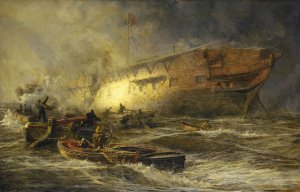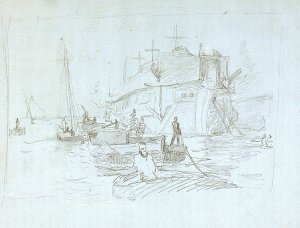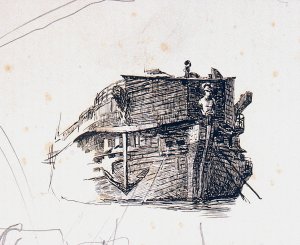During research for the ex-spanish 80-gun ship Fénix, which was captured in 1780 by the British I found some drawings showing her as HMS Gibraltar converted in 12 /1813 into a Powder Hulk.
The ship History:
Fénix was an 80-gun ship-of-the-line of the Spanish Navy, launched in 1749. In 1759, she was sent to bring the new king, Carlos III, from Naples to Barcelona. When Spain entered the American Revolutionary War in June 1779, Fénix set sail for the English Channel where she was to join a Franco-Spanish fleet of more than 60 ships-of-the-line under Lieutenant General Luis de Córdova y Córdova. The Armada of 1779 was an invasion force of 40,000 troops with orders to capture the British naval base at Portsmouth.
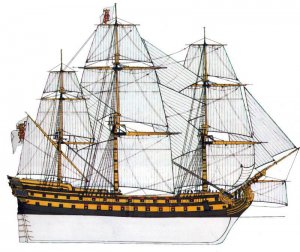
As the flagship of Admiral Juan de Lángara, the ship fought at the Battle of Cape St Vincent on 16 January 1780, where she was captured by the British Royal Navy and commissioned as the third rate HMS Gibraltar in March of that year. She spent a short while in the English Channel before joining Samuel Hood's squadron in the West Indies and taking part in the Capture of St Eustatius in February 1781 and the Battle of Fort Royalthe following month. Gibraltar and five other ships were sent to stop a French invasion fleet bound for Tobago in May 1781, but found the French too powerful and had to withdraw. In November, her 18-pound guns were replaced with 24-pounders, after which, in February 1782, she sailed to the East Indies and in the following year participated in the Battle of Cuddalore.
At the start of the French Revolutionary War, Gibraltar served in the Channel Fleet, fighting at the Glorious First of June in 1794 before being sent to the Mediterranean in May 1795. In June, the ship was in an action off Hyères; then, in December 1796, she was badly damaged in a storm and had to return to England for major repairs. By June Gibraltar was back in the Mediterranean, serving in the navy's Egyptian campaign, where she remained during and beyond the Peace of Amiens, except for a short period when she was sent home for a refit.
Returning to the Channel in April 1807, Gibraltar joined the fleet under Admiral James Gambier, which fought the Battle of the Basque Roads in 1809. This was her last major action; the ship was taken out of service in 1813 and converted to a powder hulk. She became a lazarette in 1824, then was broken up in November 1836 at Pembroke Dock.
HMS Gibraltar in June 1780
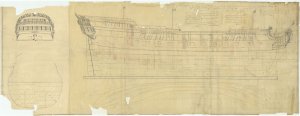
Scale: 1:48. Plan showing the body plan, sternboard with decoration detail, sheer lines with inboard detail and figurehead, and longitudinal half-breadth for Gibraltar (captured 1780), a captured Spanish Third Rate, two-decker. The plan records alterations for fitting her as a British 74-gun Third Rate two-decker. Signed by John Henslow [Master Shipwright, Plymouth Dockyard, 1775-1784]. Reverse: Scale: 1:96. Plan showing the quarterdeck and forecastle, upper deck, gun deck (lower deck), and orlop deck for Gibraltar (captured 1780), a captured Spanish Third Rate, two-decker. The plan illustrates the ship as she was fitted as a British 74-gun Third Rate, two-decker.
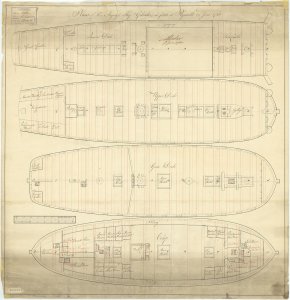
Scale: 1:96. Plan showing the quarterdeck, forecastle, upper deck, gun deck (lower deck), and orlop deck with platforms for Gibraltar (captured 1780), a captured Spanish Third Rate, two-decker. The plan illustrates her as fitted as a British 74-gun Third Rate two-decker. Signed by John Henslow [Master Shipwright, Plymouth Dockyard, 1775-1784].
and in the following the drawings of the HMS Gibraltar as Powder Hulk in March 1815:
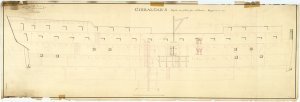
Scale: 1:48. Plan showing the inboard profile with some outboard detail for Gibraltar (captured 1780), a captured Spanish Third Rate, two-decker, as cut down and fitted for use as a Powder Hulk at Plymouth Dockyard in 1813. Signed by Thomas Roberts [Master Shipwright, Plymouth Dockyard, 1813-1815].
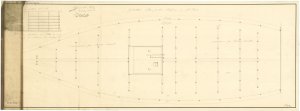
Scale: 1:48. Plan showing the platform in the hold for Gibraltar (captured 1780), a captured Spanish Third Rate, two-decker, as fitted for use as a Powder Hulk at Plymouth Dockyard in 1813. The plan illustrates the storage divisions for the powder barrels. Signed by Thomas Roberts [Master Shipwright, Plymouth Dockyard, 1813-1815].
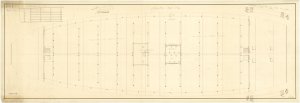
Scale: 1:48. Plan showing the orlop deck for Gibraltar (captured 1780), a captured Spanish Third Rate, two-decker, as fitted for use as a Powder Hulk at Plymouth Dockyard in 1813. The plan illustrates the storage divisions for the powder barrels. Signed by Thomas Roberts [Master Shipwright, Plymouth Dockyard, 1813-1815].

Scale: 1:48. Plan showing the lower deck for Gibraltar (captured 1780), a captured Spanish Third Rate, two-decker, as fitted for use as a Powder Hulk at Plymouth Dockyard in 1813. The lower deck used to be the orlop deck when she was a 74-gun Third Rate, two-decker. Signed by Thomas Roberts [Master Shipwright, Plymouth Dockyard, 1813-1815].

Scale: 1:48. Plan showing the upper deck for Gibraltar (captured 1780), a captured Spanish Third Rate, two-decker, as fitted for use as a Powder Hulk at Plymouth Dockyard in 1813. The upper deck used to be the lower deck when she was a 74-gun Third Rate, two-decker. Signed by Thomas Roberts [Master Shipwright, Plymouth Dockyard, 1813-1815].

Scale: 1:48. Plan showing the spar deck for Gibraltar (captured 1780), a captured Spanish Third Rate, two-decker, as fitted for use as a Powder Hulk at Plymouth Dockyard in 1813. The spar deck used to be the upper deck when she was a 74-gun Third Rate, two-decker. Signed by Thomas Roberts [Master Shipwright, Plymouth Dockyard, 1813-1815].
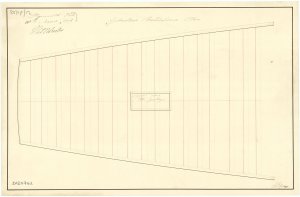
Scale: 1:48. Plan showing the roundhouse for Gibraltar (captured 1780), a captured Spanish Third Rate, two-decker, as fitted for use as a Powder Hulk at Plymouth Dockyard in 1813. The roundhouse was part of the quarterdeck when she was a 74-gun Third Rate, two-decker. Signed by Thomas Roberts [Master Shipwright, Plymouth Dockyard, 1813-1815].
http://collections.rmg.co.uk/collec...el-315247;browseBy=vessel;vesselFacetLetter=G
The ship History:
Fénix was an 80-gun ship-of-the-line of the Spanish Navy, launched in 1749. In 1759, she was sent to bring the new king, Carlos III, from Naples to Barcelona. When Spain entered the American Revolutionary War in June 1779, Fénix set sail for the English Channel where she was to join a Franco-Spanish fleet of more than 60 ships-of-the-line under Lieutenant General Luis de Córdova y Córdova. The Armada of 1779 was an invasion force of 40,000 troops with orders to capture the British naval base at Portsmouth.

As the flagship of Admiral Juan de Lángara, the ship fought at the Battle of Cape St Vincent on 16 January 1780, where she was captured by the British Royal Navy and commissioned as the third rate HMS Gibraltar in March of that year. She spent a short while in the English Channel before joining Samuel Hood's squadron in the West Indies and taking part in the Capture of St Eustatius in February 1781 and the Battle of Fort Royalthe following month. Gibraltar and five other ships were sent to stop a French invasion fleet bound for Tobago in May 1781, but found the French too powerful and had to withdraw. In November, her 18-pound guns were replaced with 24-pounders, after which, in February 1782, she sailed to the East Indies and in the following year participated in the Battle of Cuddalore.
At the start of the French Revolutionary War, Gibraltar served in the Channel Fleet, fighting at the Glorious First of June in 1794 before being sent to the Mediterranean in May 1795. In June, the ship was in an action off Hyères; then, in December 1796, she was badly damaged in a storm and had to return to England for major repairs. By June Gibraltar was back in the Mediterranean, serving in the navy's Egyptian campaign, where she remained during and beyond the Peace of Amiens, except for a short period when she was sent home for a refit.
Returning to the Channel in April 1807, Gibraltar joined the fleet under Admiral James Gambier, which fought the Battle of the Basque Roads in 1809. This was her last major action; the ship was taken out of service in 1813 and converted to a powder hulk. She became a lazarette in 1824, then was broken up in November 1836 at Pembroke Dock.
HMS Gibraltar in June 1780

Scale: 1:48. Plan showing the body plan, sternboard with decoration detail, sheer lines with inboard detail and figurehead, and longitudinal half-breadth for Gibraltar (captured 1780), a captured Spanish Third Rate, two-decker. The plan records alterations for fitting her as a British 74-gun Third Rate two-decker. Signed by John Henslow [Master Shipwright, Plymouth Dockyard, 1775-1784]. Reverse: Scale: 1:96. Plan showing the quarterdeck and forecastle, upper deck, gun deck (lower deck), and orlop deck for Gibraltar (captured 1780), a captured Spanish Third Rate, two-decker. The plan illustrates the ship as she was fitted as a British 74-gun Third Rate, two-decker.

Scale: 1:96. Plan showing the quarterdeck, forecastle, upper deck, gun deck (lower deck), and orlop deck with platforms for Gibraltar (captured 1780), a captured Spanish Third Rate, two-decker. The plan illustrates her as fitted as a British 74-gun Third Rate two-decker. Signed by John Henslow [Master Shipwright, Plymouth Dockyard, 1775-1784].
and in the following the drawings of the HMS Gibraltar as Powder Hulk in March 1815:

Scale: 1:48. Plan showing the inboard profile with some outboard detail for Gibraltar (captured 1780), a captured Spanish Third Rate, two-decker, as cut down and fitted for use as a Powder Hulk at Plymouth Dockyard in 1813. Signed by Thomas Roberts [Master Shipwright, Plymouth Dockyard, 1813-1815].

Scale: 1:48. Plan showing the platform in the hold for Gibraltar (captured 1780), a captured Spanish Third Rate, two-decker, as fitted for use as a Powder Hulk at Plymouth Dockyard in 1813. The plan illustrates the storage divisions for the powder barrels. Signed by Thomas Roberts [Master Shipwright, Plymouth Dockyard, 1813-1815].

Scale: 1:48. Plan showing the orlop deck for Gibraltar (captured 1780), a captured Spanish Third Rate, two-decker, as fitted for use as a Powder Hulk at Plymouth Dockyard in 1813. The plan illustrates the storage divisions for the powder barrels. Signed by Thomas Roberts [Master Shipwright, Plymouth Dockyard, 1813-1815].

Scale: 1:48. Plan showing the lower deck for Gibraltar (captured 1780), a captured Spanish Third Rate, two-decker, as fitted for use as a Powder Hulk at Plymouth Dockyard in 1813. The lower deck used to be the orlop deck when she was a 74-gun Third Rate, two-decker. Signed by Thomas Roberts [Master Shipwright, Plymouth Dockyard, 1813-1815].

Scale: 1:48. Plan showing the upper deck for Gibraltar (captured 1780), a captured Spanish Third Rate, two-decker, as fitted for use as a Powder Hulk at Plymouth Dockyard in 1813. The upper deck used to be the lower deck when she was a 74-gun Third Rate, two-decker. Signed by Thomas Roberts [Master Shipwright, Plymouth Dockyard, 1813-1815].

Scale: 1:48. Plan showing the spar deck for Gibraltar (captured 1780), a captured Spanish Third Rate, two-decker, as fitted for use as a Powder Hulk at Plymouth Dockyard in 1813. The spar deck used to be the upper deck when she was a 74-gun Third Rate, two-decker. Signed by Thomas Roberts [Master Shipwright, Plymouth Dockyard, 1813-1815].

Scale: 1:48. Plan showing the roundhouse for Gibraltar (captured 1780), a captured Spanish Third Rate, two-decker, as fitted for use as a Powder Hulk at Plymouth Dockyard in 1813. The roundhouse was part of the quarterdeck when she was a 74-gun Third Rate, two-decker. Signed by Thomas Roberts [Master Shipwright, Plymouth Dockyard, 1813-1815].
http://collections.rmg.co.uk/collec...el-315247;browseBy=vessel;vesselFacetLetter=G


